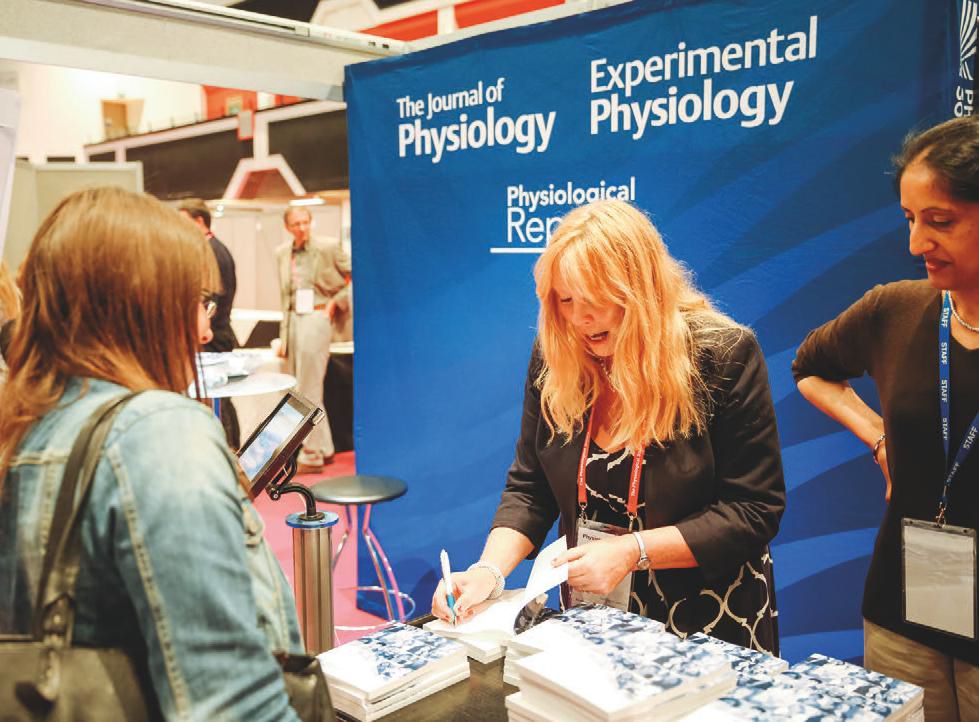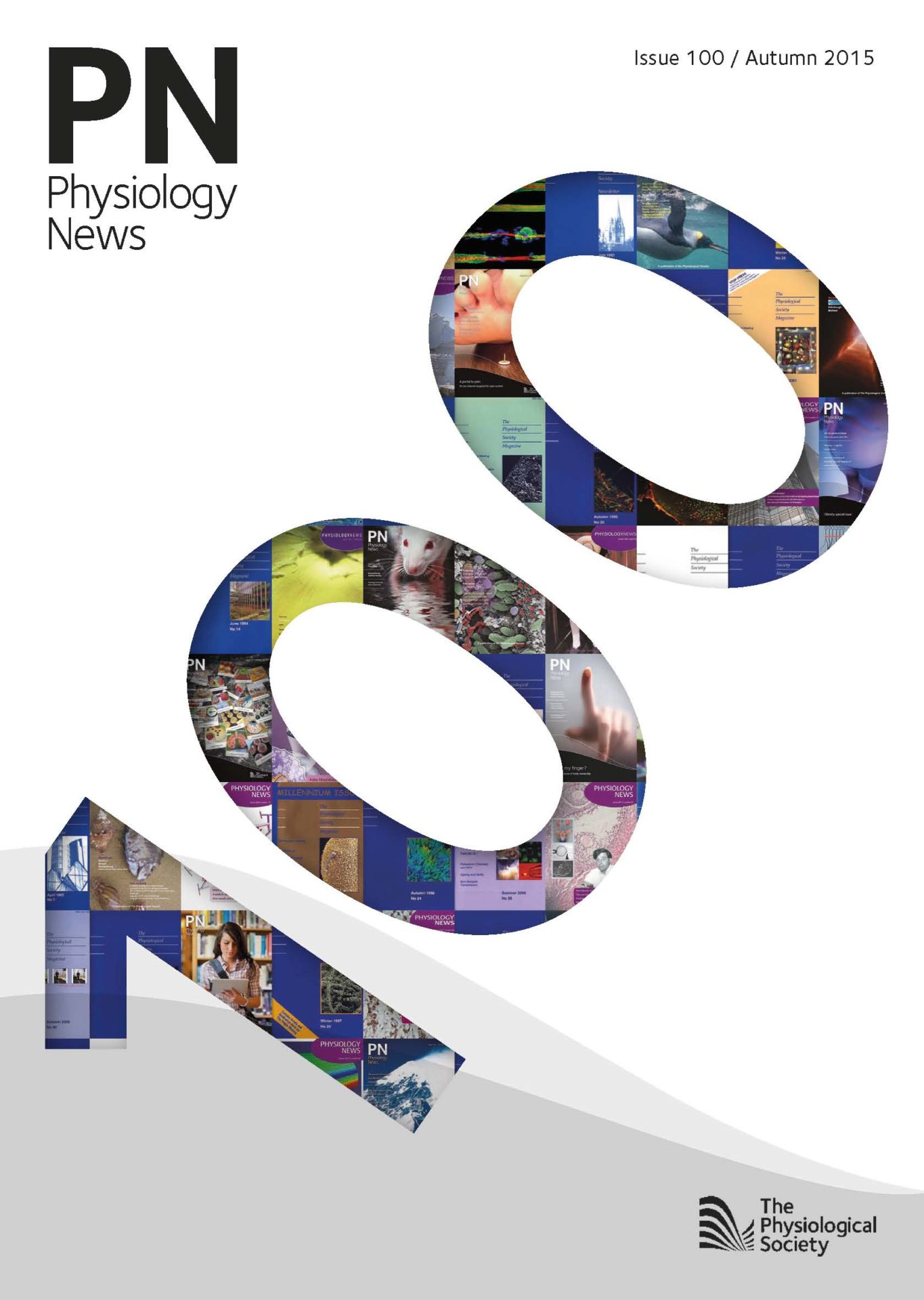
Physiology News Magazine
Physiology 2015 experiences
The Editor, a graduate student and a post-doc report on their attendance at the Cardiff meeting.
Events
Physiology 2015 experiences
The Editor, a graduate student and a post-doc report on their attendance at the Cardiff meeting.
Events
Roger Thomas
Editor, Physiology News
https://doi.org/10.36866/pn.100.15
Held in an arena designed for pop concerts with typically 5,000 rock fans, there was plenty of room for the Society meeting. The first of three days started with seven workshops, which were followed by seven symposia, and then seven sets of oral communications. These events were mostly held in a series of meeting rooms around the edge of the arena on the second floor. In the well-run symposium on astrocytes I learned that glycogen in the CNS is only found in astrocytes, and lactate is involved in signalling as well as supplying energy
To celebrate the centenary of the election of women members, all the public and prize lectures were given by women, starting with Sophie Scott of UCL talking about laughter (I restrain myself). Sophie is not a physiologist, but did include many fascinating facts, notably that laughter is one of few facial expressions recognised all over the world. Even rats will apparently laugh if tickled, and when tickled frequently will actually laugh in anticipation when the tickler enters the animal house. Not the normal reaction when physiologists enter! After the lecture there was a welcome reception in the arena. And plenty of wine.
Day two started with another seven symposia, after which there was a book launch. The book was ‘Women physiologists: Centenary celebrations and beyond’ edited by Susan Wray and Tilli Tansey. It is a glossy paperback of 170 pages, available from the Society at £5 a copy. The women featured range from the sadly late Alison Brading to the young Research Fellow Rachel Floyd. Most have a two page interview and a colour photograph. The book launch was followed by the Joan Mott Prize Lecture by Hannelore Daniel from Munich on Nutrients in the Gut. After that there was the AGM of the Society, started 5 minutes early as the President judged that there was a full agenda. He was right, the Chair from the home School (Ole Petersen) generally allowing only one question after each presentation.
The next prize lecture had to be given as a video, since Judy Harris was sadly indisposed. At the same time as this there were seven parallel sessions of Oral Communications, followed by the first of two poster sessions. Thanks to the size of the venue, there was for once plenty of room for each poster! After the poster session there was the Annual Review Prize lecture by Annette Dolphin of UCL on calcium channels and pain. The day ended with the Society Dinner in the National Museum. The drinks reception was in the upper galleries with a fine display of impressionists, while the dinner itself was in the magnificent main hall. Among the guests were Patricia Molina, the President of the American Physiological Society accompanied by her predecessor and successor. (She found the experience to be ‘…unforgettable. From the opportunity to sip champagne while perusing the lovely art collection, to the music, dinner, and collegiality amongst those attending. The highlight of the evening was getting to know David Paterson and Richard Vaughan-Jones on a more personal level during dinner’.) Diners were seated at circular tables and entertained by a live band. This required conversations to be conducted at a rather high volume. The meetings secretary, Ken O’Halloran, rounded off the dinner with a brief but witty speech.
The final day of the meeting started with another seven symposia, including a fascinating coverage of gaseous regulation of calcium homeostasis. According to one speaker, Matt Whiteman, hydrogen sulphide has a crucial role in controlling mitochondria, and offered novel therapeutic opportunities. He showed us a headline from a tabloid stating ‘Scientists say sniffing farts could prevent cancer.’ This was a consequence of an Exeter University press release stating ‘Rotten egg gas holds key to healthcare therapies.’ The final prize lecture was given just before lunch by Karin Sipido of Leuven on Calcium Microdomains in Cardiac Myocytes.

Lunch was followed by the second poster session and another five symposia. The meeting ended at 17.00. There had been a total of 115 symposium presentations, 77 oral communications, 282 poster communications, and 55 trade exhibitors, but unlike last year, no demonstrations.

Amelia Howarth
University of Edinburgh, UK
s1358506@sms.ed.ac.uk
I started my PhD in September of 2014 and, as such, had only ever been to a few internal symposia where I study, at the University of Edinburgh. A keen and avid learner of just about anything to do with science, I was looking forward to the Physiology conference and the new knowledge and new people it may bring.
Passing the initial ‘Physiology 2015’ sign, the first corridor was plastered with advertisements for bands and singers who would be performing at the venue, the Motorpoint Arena, later in the year. The rock and roll vibe was lost a little when we entered the man exhibition hall, where there were a few people standing about empty poster boards, chatting over cups of tea and coffee. I milled about a little on my own and before long it was time for the first workshop.
I’d chosen to go to a couple of the workshops and, with an interest in media, the ‘Scientists say, but how do they know?’ workshop was an obvious choice. Victoria Murphy from Sense About Science led a great discussion on leaping the gap between academic research and its appearance in the press. Victoria was bright and energetic about the topic and audience participation was rife, with people from all corners of the globe sharing their stories about working with the media. I was left with a lot to contemplate.
Inspired by the positive vibes I continued to my second workshop, ‘Gender bias in publishing’, where Sue Wray, editor-in-chief of Physiological Reports was fantastic and humorous, despite the slightly deflated atmosphere in the room. It seemed there was plenty of gender bias, but no consensus on how to solve it and the resulting feeling what somewhat disheartening. Acknowledgement of a problem, however, is the first step in solving it and I’m glad I went along. I learnt a lot and I’m grateful to be aware.
By 6.30, I was more than ready for the public lecture ‘The Science of Laughter’ being presented by the very charismatic Sophie Scott, from UCL. Did you know that during ten minutes of conversation, the average person laughs seven times? If you went to the public lecture, you probably did know that, and a lot of other blimps of interesting information gleaned from Sophie’s laid back and amusing talk.
A moment of quiet before bed that night had me realising that, true to the conferences theme of ‘100 years of Women’s Membership of The Physiological Society’, most of the interaction I’d had that day were with strong women in science, and they had all been inspiring in their engagement and enthusiasm for their work.
The next day was equally as engaging, and I continued to be struck by the amazing representation of women at the conference. Sue Wray signed my copy of ‘Women physiologists: centenary celebrations and beyond’ and I gained invaluable advice from Hannelore Daniel, winner of the Joan Mott Prize, at her talk on nutrient transport in the gut – ‘To all the youngsters, look a little bit into the antique literature… there is damn good science to be found!’. I continued to find myself surrounded by confident, independent, impressive female scientists and I decided that the ‘Women in Physiology’ theme had been a resounding success.
The Tuesday night of course also offered the conference-wide famous Society Dinner. We were greeted at the doors to the National Museum by smiling waiting staff with crisp, white shirts with seemingly unlimited glasses of champagne, who escorted us to one of the galleries where walls were full of art from the likes of Monet and Francis Bacon. My supervisor implored us to appreciate the Cézannes, but my eye was caught by a portrait of a nun sitting at a table, her hand resting on a bible, sporting the most mischievous smile I had ever seen in a painting, let alone on a nun – it’s a shame I didn’t catch the artist’s name*. Dinner and networking followed and I couldn’t keep track of all the people I was introduced to as plates of food sailed under my nose and wine flowed freely.
The next day was the day of my poster presentation and as I plastered up the A0 paper representing the last nine months of my hard work, I doubtfully listened to a wise and revered final year PhD student tell me that, often, poster presentations were the best bit of the conference. I was feeling a lot more chipper than a few of my colleagues after yesterday’s late night, but lack of sleep had me feeling less than 100% and I prepped for the poster session with some trepidation, worrying that I’d suddenly forget what a cell was or how to say phosphorylation when talking to someone terribly important.
The reality was much different and the next two hours flew by as I chatted to people from all over the UK, from all levels of academia, who were actually interested in what I had to say. I work on purinergic signalling and I met more than a few purinergic enthusiasts, who helped to make the session engaging and encouraging and I ended it on a high, thinking perhaps the two hours was not quite long enough. The wise and revered PhD student was right and I wondered how I could have ever doubted her.
*Editor’s note: The painting referred to is by Gwen John – Mere Poussepin seated at a table
Dominika Bijos
Young Urology Meeting Organising Committee
www.young-urology.org
dominika.bijos@gmail.com
Physiology 2015, the annual main meeting of The Society, was, as always, a showcase of physiology research in the UK and worldwide. This was my fourth meeting: I was no longer nervous about presenting my poster. I already knew enough people to have someone to say hello to, and each year the Physoc meeting is a way to strengthen the connections and friendships I made a year earlier.
This year there was a lot of thought-provoking science. I didn’t have a main thematic session that would anchor me to the meeting, so I ventured into new scientific fields and decided to explore what the meeting had to offer besides scientific sessions. My personal favourite were the general interest sessions with important discussions about publishing, the correct way of doing statistics, peer review, mentoring and networking. I also re-discovered the Rob Clarke awards, where undergraduates present their research data, and I visited stands of exhibiting companies and talked new chemicals, animal models and equipment. On the last day I met David Miller from the History & Archives Committee. He added my name to the physiology genealogical tree: I am a scientific granddaughter of Alison Brading – an inspiring scientific grandmother to have.
Over the three days of scientific talks, fascinating discussions and hundreds of posters, the most important new connections I made were during the never ending follow-up chats late at night (science never sleeps!). Finally, I welcomed an earlier train home (sponsored by a train strike) in the company of fellow Cambridge colleagues. I know we will see each other again – once a physiologist, always a physiologist.
